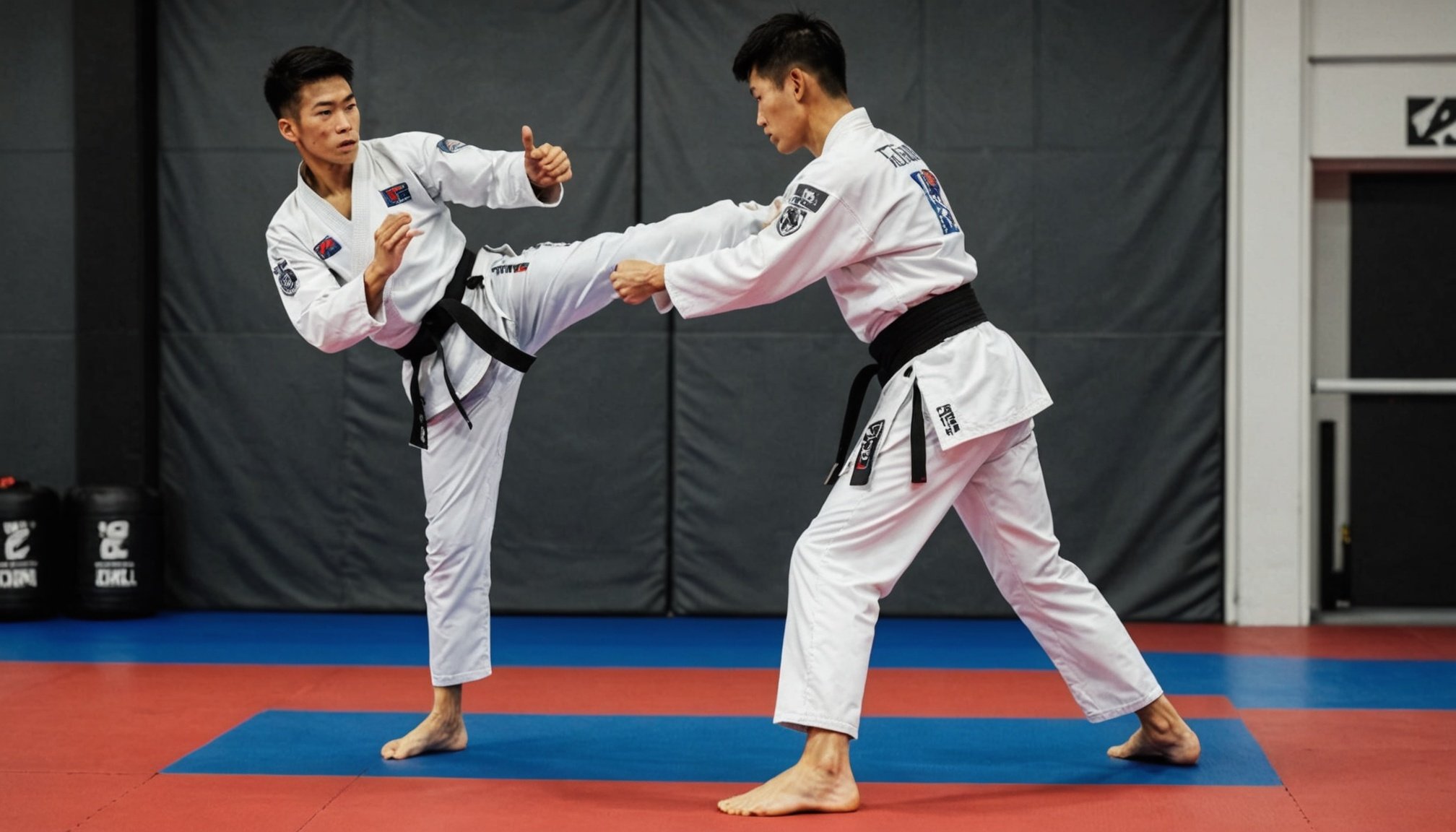Overview of Spinning Kicks in Taekwondo
Spinning kicks are a cornerstone of Taekwondo, playing a vital role in both competition and scoring. These dynamic moves include techniques like the spinning hook kick, spinning heel kick, and 360 roundhouse. Each kick demands precision and practice for effective execution in sparring.
In competitions, spinning kicks not only score higher due to their complexity but also enhance an athlete’s performance by adding unpredictability and flair to their repertoire. They reflect an athlete’s skill level, influencing judges’ perceptions and overall scoring outcomes.
This might interest you : Unleashing Potential: Ultimate Weight Training Secrets from UK Sumo Champions
For UK Taekwondo athletes, mastering these techniques is of paramount importance given local practices and competitive scenes, such as the British Taekwondo Championships. Athletes in the UK should focus on these spinning kicks to remain competitive on the national stage.
Understanding and practising these kicks can elevate an athlete’s status and open opportunities for participation in prestigious tournaments. Techniques must be part of a comprehensive training plan, ensuring that athletes not only execute them effectively but do so consistently under pressure. Adequate emphasis on the cultural and competitive relevance of these kicks can significantly impact an athlete’s growth and success.
This might interest you : Enhancing UK Martial Arts Training with Mindfulness: A Holistic Approach to Curriculum Integration
Essential Drills for Mastering Spinning Kicks
Incorporating training drills into your routine is essential for mastering the complex spinning kicks of Taekwondo. Strategic practice is key, and understanding these drills will significantly boost your performance.
Basic Spinning Kick Drill
Begin with fundamental drills to develop the core mechanics of spinning kicks. Practice slow and controlled movements to perfect your stance and balance. Focus on kicking techniques like maintaining a strong pivot foot and aligning your body for optimal power and reach. Repetition is crucial to building muscle memory, enhancing your ability to execute these demanding movements smoothly.
Partner Drills for Speed and Accuracy
Working with a partner can elevate your skill enhancement process. Partner drills are invaluable for practicing timing and accuracy. Use your partner as a target to gauge distance and speed. This not only refines your aim but also helps you understand real-time adjustments to enhance athlete performance during competitions.
Advanced Combination Drills
For more experienced athletes, integrating spinning kicks with other techniques will aid fluid movement development. Combine a spinning heel with a follow-up roundhouse to challenge coordination and improve dynamic execution. Advanced drills like these ensure your skills evolve, keeping you competitive and adaptable in diverse combat scenarios.
Technique Breakdown
Understanding the intricacies of spinning kicks is essential for maximising your Taekwondo technique. The foundation begins with a proper stance, which is pivotal for effective execution. Start with your feet shoulder-width apart, knees slightly bent to maintain balance and readiness. This stance ensures stability upon initiating the spin.
Execution Process
The execution of spinning kicks involves fluid body mechanics. Initiate the spin with a strong pivot on your supporting foot while your hips turn rapidly to generate momentum—ensuring your gaze remains on the target throughout this process sharpens your aim and reaction time.
Key Steps:
- Pivot smoothly with the rear foot supported.
- Rotate your hips maximally to harness centrifugal force.
- Keep the kicking leg bent until it reaches full extension towards the target.
Avoiding Common Mistakes
When perfecting these kicks, athletes often misalign their bodies, which diminishes power and precision. Ensure you maintain the correct alignment by practicing in front of a mirror or seeking feedback from coaches. Avoid over-rotating or losing focus on your target to enhance your athlete performance. Consistent evaluation and adjustment can significantly sharpen your skills on the mat.
Tips for Refinement
To elevate your spinning kick performance, engaging in consistent refinement is crucial. This encompasses utilizing feedback, mental visualization, and enhancing physical conditioning.
Feedback and Self-Assessment
Regularly assess your performance using video analysis. Watching playback of your kicking techniques can highlight areas needing improvement—an insightful way to refine your skills. Set weekly goals, adjusting your approach based on discovered weaknesses. Your video analysis acts as your personal coach, pinpointing nuances you might overlook during real-time practice.
Mental Visualization Techniques
Mental visualization is a beneficial tool for refining spinning kicks. Before practice, spend time visualizing each move, concentrating on your technique execution. Picture successful kicks, mastering the fluid mechanics, which enhances muscle memory and prospectively improves actual performance. Understand the importance of envisioning success right before taking action, making your movements second nature.
Physical Conditioning and Flexibility
Physical conditioning is integral to spinning kick efficacy. Maintain a regimen emphasizing flexibility to boost power and prevent injuries. Incorporate exercises that balance strength with flexibility, such as yoga or Pilates, which promote overall athletic performance. As flexibility increases, so does the fluidity and precision of your kicks, contributing to better results in competitions.
Video Demonstrations and Resources
For athletes seeking to refine their spinning kicks, leveraging diverse training videos and instructional content is invaluable. These resources offer step-by-step guides on Taekwondo techniques, expertly breaking down each move. Watching professionals execute spinning kicks can enhance your understanding and inspire confidence in your performance.
Exploring online communities and forums provides additional support, granting access to shared knowledge of athletes with varying skill levels. These platforms often host discussions on effective training drills and athlete performance, providing solutions to common challenges faced by UK Taekwondo athletes.
Engaging with local clubs and workshops gives hands-on experience under expert supervision. These environments are conducive to learning, offering tailored feedback to elevate your technique. Many workshops focus specifically on kicking techniques, ensuring relevance to those pursuing advanced training.
Video demonstrations often present clear, visual guides to correct technique, helping you avoid mistakes that could impede progress. These resources are valuable for both beginner and seasoned athletes, ensuring you remain competitive and adaptable, whether training solo or within a group. Embrace these digital tools to maximise your potential in mastering stunning spinning kicks within Taekwondo.
Considerations by Skill Level
Understanding how spinning kicks adapt to different skill levels in Taekwondo is vital. With tailored approaches, both novice and experienced athletes can enhance their Taekwondo techniques and overall athlete performance.
Drills for Beginners
Beginners should focus on simple drills that promote balance and basic coordination. Start with simple spinning motions, paying attention to maintaining weight on the back foot. Consistency in practice helps build the foundational skills needed for effective spinning kicks.
Intermediate Skill Development
For intermediate athletes, incorporate combination drills. Link basic spinning kicks with straightforward strikes or blocks. This integration enhances versatility and sharpens decision-making skills in dynamic sparring scenarios. Regularly practising combinations builds a more comprehensive skill set.
Advanced Training Techniques
Advanced athletes must push their limits by practising under unique conditions. This could include executing spinning kicks with added weights or on uneven surfaces, enhancing strength and adaptability. Furthermore, focus on rapid transitions between different spinning kicks, which challenges precision and stamina under competitive pressure.
By adjusting training methods to cater to different proficiency levels, athletes can develop their spinning kicks effectively, ensuring sustained growth and higher competence in competitions.






